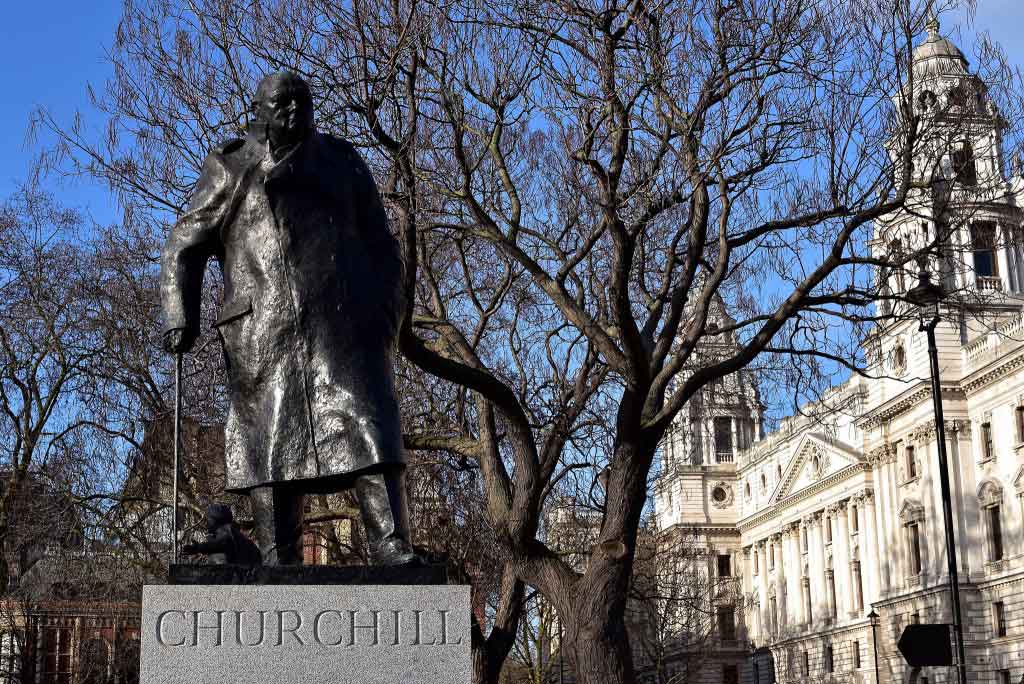
Finest Hour 155
Leading Churchill Myths – The Myth of the “Black Dog”

Winston Churchill, Parliament Square, London © Sue Lowry & Magellan PR
March 22, 2013
Finest Hour 155, Summer 2012
Page 28
Leading Churchill Myths – The Myth of the “Black Dog”
Churchill Did Have Dark Moods, But He Was Not Bipolar
By Carol Breckenridge

2025 International Churchill Conference
Carol Breckenridge MA, ATR-BC was a practicing art therapist for over twenty years and is now Adjunct Professor at Ursuline College, Pepper Pike, Ohio, in the graduate art therapy program. This article will be posted with its predecessor “Leading Myths” on The Churchill Centre website.
Abstract
Churchill would be surprised to know that his many references to his innocent childhood phrase “Black Dog,” an expression of Victorian nannies to connote bad moods, would be used after his death to declare him mentally ill. Jock Colville, his onetime private secretary, warned that the hypothetical depression “revealed” in Lord Moran’s diaries, through WSC’s use of this expression, would become “accepted dogma.” It certainly has.
A Google search for “Churchill and Depression” produces page after page of articles and references to books that discuss Churchill’s alleged serious depression. There are those who believe he had Manic Depression (now known as Bipolar Disorder) and there’s another group who believe he suffered from Major Depression. The National Association for the Mentally Ill (NAMI) includes Churchill, along with Abraham Lincoln and Beethoven and Tolstoy to name a few, in their list of famous personages who lived with mental illness. NAMI specifies that this is a list of those who suffered with Bipolar Disorder and Schizophrenia.
The literature on this topic is of two types. The first is by writers who are qualified to make a diagnosis but have superficial knowledge of Churchill. A recent example is Nassir Ghaemi’s A First Rate Madness (reviewed on page 44)—the premise of which seems to be that mental illness is present in many if not most great leaders. The second is by writers who are knowledgeable about Churchill’s life but have a superficial understanding of mental illness: John and Celia Lee’s recent book The Churchills, for example, flatly asserts in a footnote that Churchill was Bipolar. Either way, the myth of the “Black Dog” is central to their conclusions.
As an art therapist working for twenty years in outpatient mental health, I have seen hundreds of patients who were Bipolar or had Major Depression, and children diagnosed with Attention Deficit Disorder with Hyperactivity (ADD-H). Churchill’s childhood and painting have long interested me. I presented a peer- reviewed paper for the American Art Therapy Association exploring my thesis that the young Churchill had ADD-H, and continued to cope with many of those traits in his adult life. I do not purport to examine Churchill’s medical minutiae, nor to propose that he never suffered from milder forms of depression. I do, however, object strongly to sweeping generalizations about his alleged Bipolar Disorder.
More biographers should follow the example of one who spoke at the International Churchill Conference in Charleston, South Carolina. He disagreed, he said, with the assertion that Churchill suffered from serious depression, so he presented an anonymous description of Churchill’s personality, symptoms and achievements to three distinguished psychiatrists. Independently, each agreed that no one who was able to achieve so much could have suffered from Bipolar Disorder or Major Depression. Mental health professionals in the conference audience agreed.
Bipolar Disorder is a severely disabling mental illness. Without medication, victims have difficulty maintaining relationships or employment. Their lives are chaotic, and often unproductive. They are unable to focus and lack the energy to marshal their thoughts even to write a convincing letter to the editor, much less fifty books. They are not likely to create 500 paintings or support a family of five in an upperclass way of life, or become one of the world’s most highly paid journalists.
The psychiatric state formerly called Manic Depression is still the core of the Bipolar diagnosis, according to The Diagnostic and Statistical Manual of Mental Disorders (DSM). Using the list of symptoms for a Major Depressive Episode, Churchill would need to experience at least five symptoms which “have been present during the same two week period and represent a change from previous functioning; at least one of the symptoms is either (1) depressed mood or (2) loss of interest or pleasure.”
The DSM notes that these symptoms cannot be due to a general medical condition, such as the circulatory illnesses (heart attacks and strokes) that Churchill experienced in the last twenty-five years of his life when Lord Moran served as his physician. Let us consider the DSM’s nine criteria for “Major Depressive Episodes”:
1. Depressed Mood
Churchill did have dark moods during periods of his life when his talents were underutilized or he’d suffered serious personal or professional losses. His term for these moments was “Black Dog,” a common description of Victorian nannies to characterize their charges. “Black dog on my back” roughly corresponds to getting out on the wrong side of the bed. His daughter, Lady Soames, stated that her father was not depressed unless he had good reason. For instance, after the terrific loss of life in the Dardanelles disaster, she said he would have had to be a “monster of insensitivity” not to be depressed. Historians, she added, have made “rather a big meal” out of the Black Dog, echoing Colville’s concern. Sadness after periods of loss and devastating events is called grief, not clinical depression.
2. Diminished Interest or Pleasure
When Churchill lost his position of First Lord of the Admiralty, following the resignation of First Sea Lord Fisher over the failure of the Dardanelles campaign in 1915, he certainly felt bereft, writing in his essay, Painting as a Pastime: “Like a sea beast fished up from the depths, my veins threatened to burst from the fall in pressure.” But did he show no interest in life’s activities? On the contrary, he threw himself into his new hobby of painting, while planning to salvage his political career. His recollection of his rescue by “The Muse of Painting” is as joyful an account as could be rendered by anyone with his burdens at that time.
3. Significant Weight Change
Churchill was throughout most of his life a burly figure, but he never appeared significantly obese until perhaps the last years. But contemporary photographs from 1915 and other critical periods do not support any rapid weight gain or loss during this or similar depressing experiences.
4. Insomnia or Hypersomnia
Churchill seemed to need less sleep than the average person, but he said this was owed to his practice of an afternoon siesta, which he had learned in Cuba in 1895. The very drive that kept him writing and dictating until the wee hours again belies the notion that he lost interest in life.
5. Psychomotor Agitation or Retardation
Churchill was an active man, playing polo into his fifties and riding to hounds in his seventies. The DSM’s descriptive material does not refer to exercise, or even common movements such as twitching a foot or pacing while dictating. They describe, rather, an extreme movement that others observe with alarm: hand-wringing, for example, or repeated rubbing of the skin. In his sixties and seventies Churchill’s energy was amazing, but his activities were goal-directed and reasonable.
6. Fatigue or Loss of Energy
Before his last two decades, Churchill rarely exhibited energy loss or fatigue; on the contrary, he was often described as indefatigable. Even after his circulatory illnesses began to take their toll, colleagues found it hard to keep pace with him. Some might sunbathe and read a book on vacation; Churchill chose to paint for hours, working his brushes and palette until he was in his mid-eighties.
7. Feelings of Worthlessness; Inappropriate Guilt
Churchill, who said “I do believe I am a glow-worm,” believed in his destiny. As a young man he did not feel he could be killed as he rode in a cavalry charge heedless of bullets. When faced with defeat he licked his wounds and found a new project. Churchill’s ego in his prime was the equal of any man, and in his youth he was able to withstand the scathing appraisal of his father Lord Randolph, who wrote disparagingly of his son’s self-confidence when Churchill was finally admitted to Sandhurst. As a very old man he reflected that he had done a great deal, only to do little in the end; but these are often the reflections of the aged, and Churchill was a man capable of serious reflections on history and his role in it. Even in those years he was wont to retort to an errant valet, “But I am a great man,” and he certainly exhibited no guilt over his life’s work.
8. Diminished Concentration; Indecisiveness
Throughout his career Churchill was lauded for his
sharp mind and the ability to think on his feet, even by those who disagreed with him. His speeches in Parliament usually drew an audience. Even with alcohol coursing through his veins, he was able to work efficiently into the night, to focus and to make decisions.
9. Recurrent Thoughts of Death
Suicidal ideation has been anecdotally noted in Churchill in old age by his physician, Lord Moran, who says WSC did not like to stand next to a train track, fearful of being overtaken by an urge to jump. No other colleague ever recorded this, and Churchill said that he had no wish to commit suicide. A Freudian might say that his fear was derived from an unconscious death wish which proved that Churchill had suicidal thoughts. A non-Freudian might consider that Churchill had always been impulsive— and curious—and that in maturity he was aware of this trait. Interestingly, impulsivity is one of the DSM criteria for Attention Deficit Disorder with Hyperactivity, which is not our purpose here to dispute.
Reexamining Churchill’s “mental illness,” therefore, we cannot satisfy the five criteria required for a “Major Depressive Episode.” (The criteria for milder forms of depression are simply milder versions of the same list, minus suicidal ideation.) But let us examine the criteria for a Manic Episode, since so many are determined to give Churchill the Bipolar diagnosis.
The Manic Episode must last at least seven days—or less if the patient was hospitalized as a result of his behavior. A Hypomanic Episode is differentiated as a mood that lasts four days, but does not “cause marked impairment in social and occupational functioning, or necessitate hospitalization.” The DSM states, however, that the symptoms must be “a clear change in functioning that is not characteristic of the individual’s usual functioning.” Both Hypomanic and Manic have the same list of seven symptoms, only three of which are required to qualify. The main difference between the two is the severity of the symptoms and the effect on functioning.
Consider the DSM’s criteria for a “Manic Episode”:
1. Inflated Self-esteem or Grandiosity
Does thinking of oneself as a “glow-worm” or a “great man” imply inflated self–esteem or simply a healthy appraisal of self-worth? Was this not the same man who once observed that he was probably the worst Chancellor of the Exchequer there ever was? This does not seem to be a situation in which there was a significant change, since even as a child and youth Churchill thought well of himself.
2. Decreased Need for Sleep
Churchill’s sleep patterns of short nights with daytime energizing naps was not a pattern that came and went. It was his constant pattern during most of his life, and therefore not an “episode.”
3. Pressured Speech; Increased Talking
Manifestly Churchill liked to talk, and usually dominated dinner party conversation. So does my husband. However, if circumstances required Churchill to listen, there are many incidents when he displayed that he could do so—the most famous being the “long silence” following Chamberlain’s query about who should succeed him in May 1940: “As I remained silent a very long pause ensued. It certainly seemed longer than the two minutes which one observes in the commemorations of Armistice Day. Then at length Halifax spoke”—and delivered Churchill to the Premiership. People who have pressured speech cannot help themselves; Churchill could.
4. Racing Thoughts; Flight of Ideas
This refers not to a person with a lot of good (or bad) ideas, like Churchill, but rather to one who finds it is hard to focus, decide, or sort through those ideas in a logical way. Could Churchill have written fifty books with an inability to focus? Could he have spent thousands of hours in front of his easel, or serve in every cabinet position except Foreign Secretary? Clearly this was not his problem.
5. Diminished Concentration
6. Psychomotor Agitation
These are covered in the discussion of Major Depression.
7. Excessive Pleasurable or Dangerous Activity
Churchill’s energy as an adult was focused but not pathological. He had no fear of anything, and some of the adventures he indulged in were indeed risky; the decision to pursue them often seemed impulsive, and Clementine sometimes chastised him for the risks he took. But was this involvement “excessive”? Clearly not; he took life as it came: When dangerous situations occurred, he did not shrink, but neither did he seek them out to the exclusion of all else.
Manic symptoms 3-7 are also indicative of Attention Deficit with Hyperactivity. It is possible too that the young Churchill could have be diagnosed with ADD-H as it is known now—and that its very traits became his strengths as an adult. The DSM, noting this congruity of symptoms, states that ADD-H can only be diagnosed in place of a Manic Episode if the symptoms have been present since childhood—Churchill’s case. His teachers found him easily distracted. But like most bright children with ADD-H, he excelled when his interest was engaged. He was so full of energy that his mother found him difficult to manage without the aid of his nanny; his energy had an impulsive nature and he enjoyed situations with an element of danger.
The Diagnostic and Statistical Manual of Mental Disorders states that “periods of sadness are inherent aspects of the human experience.” This was certainly true of Churchill, who lived a life that was quite human and profoundly inspirational. He was a man with a huge personality who enjoyed life, family and the fulfillment of destiny without the hobble of a debilitating mental illness. The myth of the “Black Dog” as Churchill’s metaphor for a severe clinical mood disorder is just that—a myth.
Subscribe
WANT MORE?
Get the Churchill Bulletin delivered to your inbox once a month.



